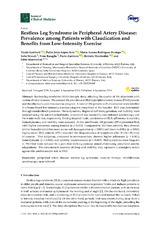Restless Leg Syndrome in Peripheral Artery Disease: Prevalence among Patients with Claudication and Benefits from Low-Intensity Exercise
Autor
Lamberti, Nicola
López Soto, Pablo Jesús
Rodríguez Borrego, M.A.
Straudi, Sofia
Basaglia, Nino
Zamboni, Paolo
Manfredini, Roberto
Manfredini, Fabio
Editor
MDPIFecha
2019Materia
Peripheral artery diseaseRestless leg syndrome
Exercise therapy
Rehabilitation
Spectroscopy
Near-infrared
METS:
Mostrar el registro METSPREMIS:
Mostrar el registro PREMISMetadatos
Mostrar el registro completo del ítemResumen
Restless leg syndrome (RLS) disrupts sleep, affecting the quality of life of patients with various chronic diseases. We assessed the prevalence of RLS in peripheral artery disease (PAD) patients and the effects of a pain-free exercise program. A total of 286 patients with claudication were enrolled in a home-based low-intensity exercise program prescribed at the hospital. RLS was determined through standardized questions. Hemodynamics, degree of calf deoxygenation, and mobility were assessed using the ankle-brachial-index, a treadmill test assisted by near-infrared spectroscopy and the 6-min walk test, respectively. During hospital visits, persistence of RLS, adherence to exercise, hemodynamics, and mobility were assessed. At the enrollment, 101 patients (35%) presented RLS, with higher prevalence among females (p = 0.032). Compared to RLS-free patients, they showed similar hemodynamics but more severe calf deoxygenation (p < 0.001) and lower mobility (p = 0.040). Eighty-seven RLS patients (83%) reported the disappearance of symptoms after 39 (36−70) days of exercise. This subgroup, compared to nonresponders, showed higher adherence (p < 0.001), hemodynamic (p = 0.041), and mobility improvements (p = 0.003). RLS symptoms were frequent in PAD but were reduced by a pain-free walking exercise aimed at inducing peripheral aerobic adaptations. The concomitant recovery of sleep and mobility may represent a synergistic action against the cardiovascular risk in PAD.

